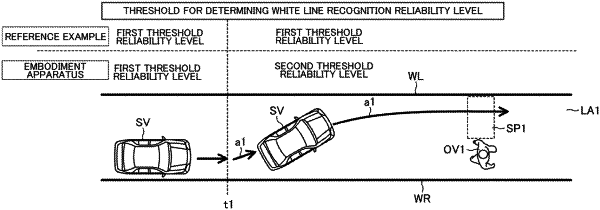| CPC B60W 30/09 (2013.01) [B60W 10/20 (2013.01); B60W 30/0956 (2013.01); B60W 10/18 (2013.01); B60W 2552/53 (2020.02)] | 2 Claims |

|
1. A collision avoidance assist apparatus, comprising:
a lane marking recognition device which recognizes a left lane marking and a right lane marking provided on a road on which a vehicle moves;
an obstacle recognition device which recognizes an obstacle in an area ahead of the vehicle;
an electric motor which applies a steering torque to a steering mechanism including a steering wheel of the vehicle to change a steering angle of at least one steered wheel of the vehicle; and
an electronic control unit configured to:
calculate a lane marking recognition reliability level representing a reliability level of an overall recognition result on the left and right lane markings; and
execute an emergency steering control including processes to:
determine a target steering torque which changes the steering angle to avoid a collision of the vehicle with the obstacle without moving the vehicle out of the moving lane when (i) the electronic control unit determines that the vehicle has a high probability of colliding with the obstacle, (ii) a moving lane defined by the left and right lane markings is a straight lane, and (iii) the calculated lane marking recognition reliability level is equal to or higher than a first threshold reliability level; and
drive the electric motor to apply the steering torque corresponding to the determined target steering torque to the steering mechanism,
wherein the electronic control unit is configured to stop executing the emergency steering control when the lane marking recognition reliability level becomes lower than a second threshold reliability level set to a value lower than the first threshold reliability level.
|